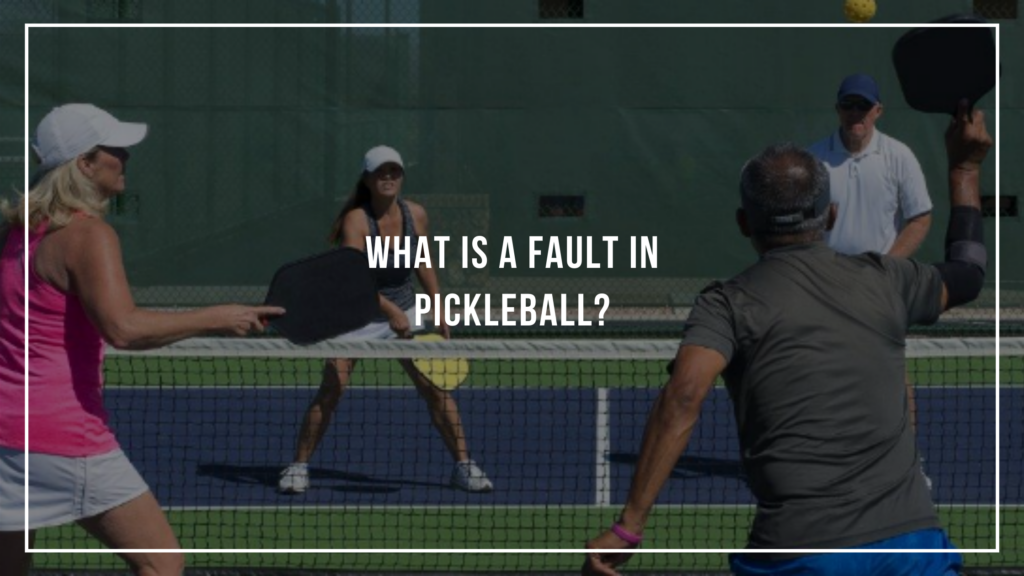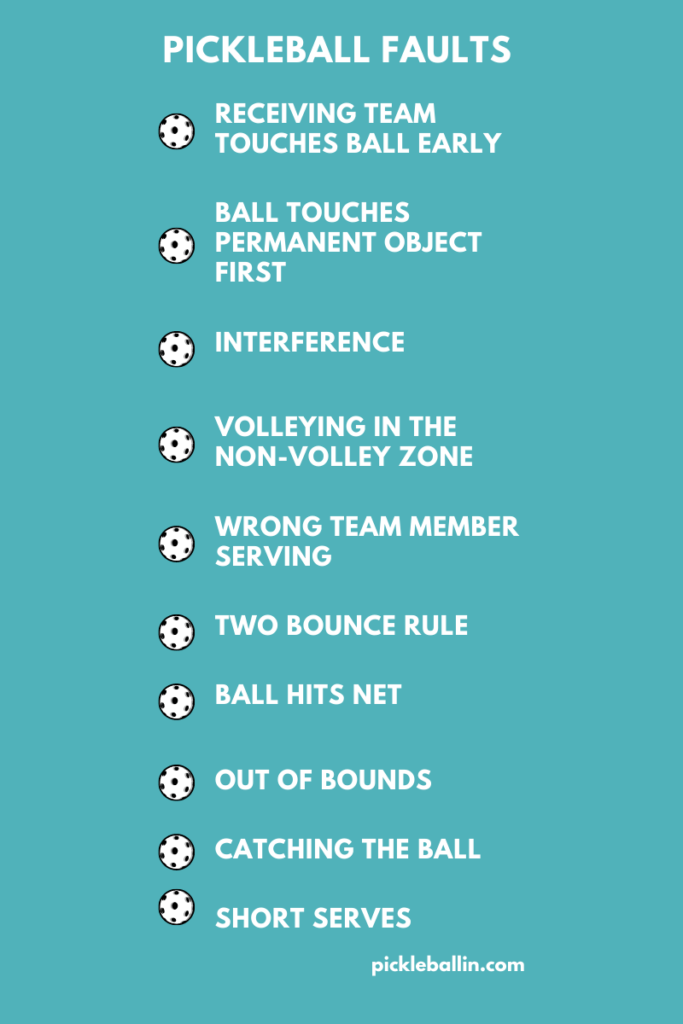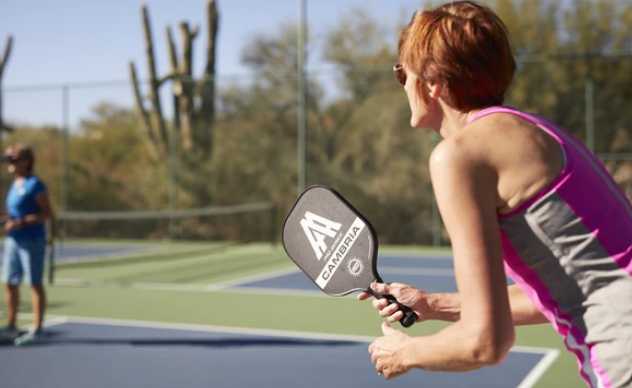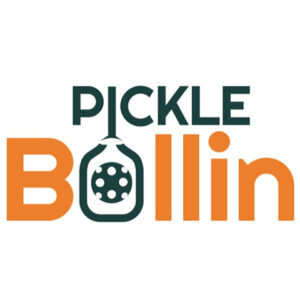
Pickleball is a popular game for single teams, friendly competitions, or whole families. It’s important to know the rules regarding legal plays and penalties if you’re wondering “what is a fault in pickleball”.
In pickleball, a penalty, referred to as a fault, results in a stop of play. The fault ruling determines what happens next, which can be a point scored for the serving team, a loss of a serve, or a side out. There are 10 faults in pickleball that we’re going to discuss.
Faults can be against the serving team – the team with the ball; or against the receiving team – the team who gets the ball.
If you’re looking for a complete beginner’s guide to pickleball check out: Pickleball Strategy: Complete Beginners Guide !
!
Pickleball Faults

There are 10 faults in pickleball. When one of the following faults occurs, play stops, and the offending team receives a penalty. Understanding these pickleball faults will help you play a better game of pickleball and reduce your faulting chances.
A point is earned or a serve is lost if a fault occurs. Remember, as in volley ball a point can only be scored by the serving team. A fault occurs on a serve when the ball hits short of the service court including the non-volley line. If the ball is served to the wrong court, long behind the back service line or out of the bounds that is a fault.
pickleballcanada.org
Receiving Team Touches Ball Early
One of the top rules of pickleball is that the ball must clear the net before being touched by the receiving team. Furthermore, after the serve comes across the net, it must bounce on the court before a player can answer. This bounce is a volley shot.
The opposing team must wait to return the ball until it has come over the net and into their court, and they must wait until the ball has made contact with the ground in their area.
If a player acts early on either of these steps, either by returning the ball before it hits the ground or passes the net, the fault will be on the receiving team. This ruling causes the serving team to gain a point.
Ball Touches Permanent Object First
If a ball touches anything other than the court before it lands on the receiving team’s side, there will be a fault. This fault usually happens more often indoors than outside.
Objects of interference that can cause a ball to fault are obstacles like basketball rims, ceiling panels, light fixtures, and other equipment. This fault does not include the ball hitting a player.
Interference
In pickleball, it is legal for a player to position themselves to influence or intimidate the server. However, rules prevent intentional distraction, including screaming, waving their arms, jumping, or other interference. If a player performs a fault of deliberate behavior, they can face a penalty.
But if a server volleys a ball into the receiving team’s court and hits a player (including clothing or equipment) before it bounces on the court, it becomes a fault against the serving team.
Volleying in the Non-Volley Zone
Volleying in the non-volley zone (the kitchen) is in the top 5 faults in pickleball. This fault occurs when a player volleys (hits a ball in the air) while standing with their feet on the non-volley zone. This zone is a 7’x20’ rectangle on each side of the net.
When serving or volleying a shot, you cannot step onto or over the no volleying line. This rule also pertains to your forward momentum, which may push you over the line after hitting the ball.
If any part of you, including equipment, clothing, and jewelry, goes into the NV zone during a volley play, it’s a fault against your team. It does not matter if the opponent team returned the ball or missed.
However, it is legal to enter the NV zone by making a groundstroke or to hit a ball that bounces within the boundaries. The rule only pertains to when hitting the ball in the air.
Wrong Team Member Serving
Pickleball has clear rules regarding player order and service sequence. Once the game starts, each team’s responsibility is to ensure they’re in the proper positions.
The team also has to be sure the right player serves the ball to the correct court. A fault for a serve to the wrong court or the wrong server will result in a side-out or loss of service.
The serving team receives an automatic point for a fault where the wrong player from the receiving team responds to the serve.
Two Bounce Rule
In pickleball, there’s a clear rule regarding the ball bouncing twice before it is legal for either team to hit a volley in the air.
A served ball must bounce in the receiver service court before the receiving team can return it to the other side.
The serving team must wait for the ball to bounce back in their court before returning the serve to the receiving side. They cannot rush up to hit the ball in the air.
Once the ball returns to the receiving side and is still in play, it is open to hit the volley in the air rather than wait for the ball to bounce. Remember, two bounces, one on each side of the court.
Ball Hits Net
Another automatic fault happens when considering “what is a fault in pickleball” is if the ball hits the net at any time during a serve or a return from the receiving team.
The fault is on whichever team completed the incomplete serve. How the game will proceed depends on how the ball hits the net. If the ball makes it into the receiving team’s court after hitting the net, it’s a let, which allows for a reserve.
If the ball lands in the kitchen or touches the kitchen line after hitting the net, it’s a fault against the serving team, and they lose the point.
Out of Bounds
If a ball falls out of bounds, it is a fault against the team that hit the ball. The ruling results in a stop play. When the blame is on the serving team, they lose their point, and the ball goes to the receiving team to serve.
If the receiving team hits the ball out of bounds during a return, the serving team gets the point, and the play ends.
Catching the Ball
If a ball is heading out of bounds, it is a fault if a player reaches out to catch the ball. Instead, a player should let the ball go, which will result in a mark against the team who served it out of bounds.
Short Serves
If the server hits the ball over the net, but it’s a short hit that falls inside the non-volley zone, it becomes a fault against the serving team. They lose their turn to serve and the chance to score.
The receiving team then gets the ball to serve and attempt to rally (score a point).
Conclusion

We’ve listed ten common faults in pickleball, which can rule against the serving or receiving team. When a fault happens, the play stops, and the team responsible will get penalized. Fault penalties can result in a loss of a point or serve. A rally continues until a fault occurs, and only the serving team can score during this time.
Looking for more? Here are some of our other guides we recommend:
Learn: About Pickleball , Why is it Called Pickleball?
, Why is it Called Pickleball? , Pickleball Rules
, Pickleball Rules , Pickleball Court Dimensions
, Pickleball Court Dimensions , What is Pickleball?
, What is Pickleball? , and Pickleball Singles vs Doubles – Strategies and Rules
, and Pickleball Singles vs Doubles – Strategies and Rules .
.
Equipment: Best Pickleball Clothes for Men and Women , Best Pickleball Accessories And Must-Have Gear
, Best Pickleball Accessories And Must-Have Gear , Best Pickleball Paddle in 2021, and Men’s Pickleball Shorts.
, Best Pickleball Paddle in 2021, and Men’s Pickleball Shorts.
